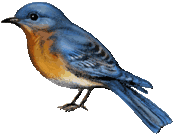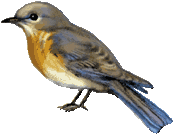|
 
Diet
Bluebirds eat mainly insects and berries. They eat a variety of insects, including crickets, grasshoppers, beetles;
also spiders, earthworms, snails and rarely small lizards or treefrogs. (1)
General Behavior
Forages by perching low and fluttering down to ground to catch insects. Bluebirds often hover to catch bugs instead
of landing. May also catch bugs in midair. Feeds on berries by perching or making short hovering flights in trees.
(1)
Courtship
Main behavior: Song, Flight-display, Wing-wave
Duration: For a few days after the arrival of the female on the territory
The male bluebird may sing a great deal before the female arrives on the territory. Male may sing as often as twenty
times / minute. Once female arrives, he sings slower at about five to ten times / minute.
When male first arrives on territory, or arrives with female, he will start courtship with several displays. The
Flight-display with song ends up at a prospective nest site. At the potential nest site he will cling to the entrance
or a nearby perch and do Wing-wave while continuing singing. Afterwards he may go to the nest hole and rock back
and forth, putting his head and shoulders in an out of the nest hole and looking around between each rocking motion.
He may have a little bit of nest material in his beak while doing this.
The male may also land on the nest site (or nest box,) droop his wings, spread his tail and expose his vibrant
blue back to the female. He may lift and quiver his wings and pivot, appearing to dance.
(Four elements of early courtship are thus: Song, Flight-display, Wing-wave and poking head in and out of nest
hole. These can be done in any order, and may be repeated many times at same or different nest hole.)
Female shows little interest at first, but will gradually approach the nesting hole. Often, male will then enter
hole and sing softly. Female usually leaves after first visit. The male keeps repeating displays. She often approaches
several boxes before she finally enters one. She may also Wing-wave and give song between visits.
If the female bluebird enters a nest hole while the male is inside, there is a good chance they are paired. Following
entering, she takes more of the lead around the nest site and is usually able to displace the male from any place
that she flies to. She may be dominant over the male at this point or sometimes not.
Following initial courtship both will do fewer displays. They keep in contact with a soft Tur-a-wee call and may
do wing-wave when coming together.
Courtship feeding continues throughout the early part of breeding. The male will bring food to the female who may
crouch, flutter her wings and make peeping noises.
Copulation may occur before nest building and continue into the incubation phase.
Bluebirds are usually monogamous. Occasionally a bluebird finds a new mate for a second brood during a nesting
season. There are recorded instances of polygamy.
Both cases of 2 males / I female and I male / 2 females (with two nests) have been observed
Nest Building
Placement: in a natural tree hole or a nesting box.
Size: inside diameter 2 1/2 -3 inches
Materials: base of fine grasses, pine needles, weed stalks and fine twigs, inner lining of finer grasses, and rarely
hair or feathers
Nest may or may not have fine inner lining.
Female selects final nest site after seeing many of the male's potential sites. One to six weeks may pass from
selection of site to actual nest building. A female may start to build several nests, then pick one in which to
lay her eggs.
The nest is built primarily by the female. Male may bring occasional bits of material to add to nest.
Building may take from two to twelve days, usually accomplished in four or five.
Cold weather may temporarily stop nest building.
Breeding
Eggs: usually 4 or 5. They are clear blue or, occasionally white.
Incubation: 12-18 days, average 13-14, by female only
Nestling phase: usually 16-20 days
Fledgling phase: 3-4 weeks
Broods: 2 or 3 per year
Egg lying may not begin until a week after completion of nest.
One egg per day is usually laid, usually before midmorning.
Incubation begins after last egg is laid.
Male may come to nest when female is gone ("on break') but he doesn't sit on eggs. Male brings food to female
throughout incubation period.
Female may stick her beak into nesting material and vibrate in what is known as "tremble-thrust." It
is believed this shakes parasites and other debris down to the bottom of nest and away from young (perhaps increasing
their survival rate.)
Occasionally a female may lay an egg in another female's nest in what is known as egg-dumping. Studies show that
9% of bluebird nests have young from more than one mother or more than one father. Some of these cases may be due
to the female mating with more than one male.
Nestling Phase
Young hatch approx. in order they were laid.
There can be one or more unfertile eggs in clutch.
Shells may be carried away or eaten.
Young are at first naked - covered only with scattered gray down. Female broods them for first few days to keep
them warm, until they get more feathers and can regulate own body temperature.
At first male brings most of the food, giving it to female who feeds young. Later when female doesn't need to brood
young as much, both parents gather food and both feed it directly to young.
At first young get soft insects, such as small caterpillars. Later they get adult insects such as beetles and grasshoppers,
sometimes berries.
Young grow very fast; eyes open on 4 th - 7 th day. Primary wing feathers show on fourth day, and tail feathers
on the eighth day.
For the 1st week young give only peeping sound which changes to a harsher "zee" in 2nd week.
By the 12th day, the young weigh almost as much as the adults and their down has been replaced by the blue and
gray juvenile plumage. By the 15 th day they are completely feathered.
In early days of nestling phase the adults may eat the fecal sacs. By the 7th day they carry them up to 50 yards
away.
If one of the nestlings die the parents may remove it from the nest if it isn't too big for them to handle.
Fledgling Phase
The time when young leave nest varies. If they are disturbed during late nestling phase, they may leave the nest
prematurely at great risk to their survival. Generally they leave when 17-20 days old. This is proceeded by the
adults feeding them less until they leave the nest.
The whole brood may leave nest within a two-hour time span, some of the brood may wait longer or even until the
next day.
On first flight they can fly up to 75 or 100 yards, often landing in lower branches of a tree then working up to
higher branches.
They usually give Tur-a-wee call as soon as they leave the nest. This helps parents locate them during food trips.
Both parents continue feeding for three to four weeks. If female starts another brood, the male only will continue
feeding the fledglings.
The female may build a new nest for second or third brood, perhaps in same nest box. She may begin her new brood
as early as 3 or 4 days after her earlier brood has fledged. Occasionally some of the young from the first brood
stay around the nest and help feed the nestlings of the following brood.
If a nesting site "fails" the pair may not stick together and may move as many as 10-12 miles to a new
nest site, although 3-5 miles is probably more common.
The most common causes of nest failures is bad weather or predation by raccoons, other mammals, snakes, house wrens
or house sparrows.
Plumage
Male has bright blue feathers on back and head. Females have grayish blue plumage on back and head. Juveniles plumage
is similar to adult female but has brownish spots all over breast. Juveniles molt partially in August and September,
when spots are lost. Then they resemble adults. Adults molt once per year in August and September.
Migration
Bluebirds migrate in winter to S.E. United States and to Mexico and Central America. This occurs in October and
November. Some birds occasionally will not migrate if food is plentiful and the last nesting attempt was successful.
Sometimes these
wintering parents may stay with their offspring as a family unit until the next breeding season.
Flock Behavior
Bluebirds often move about in small flocks of five to ten birds. They may feed
together on fruits and berries, or come to birdfeeders
|